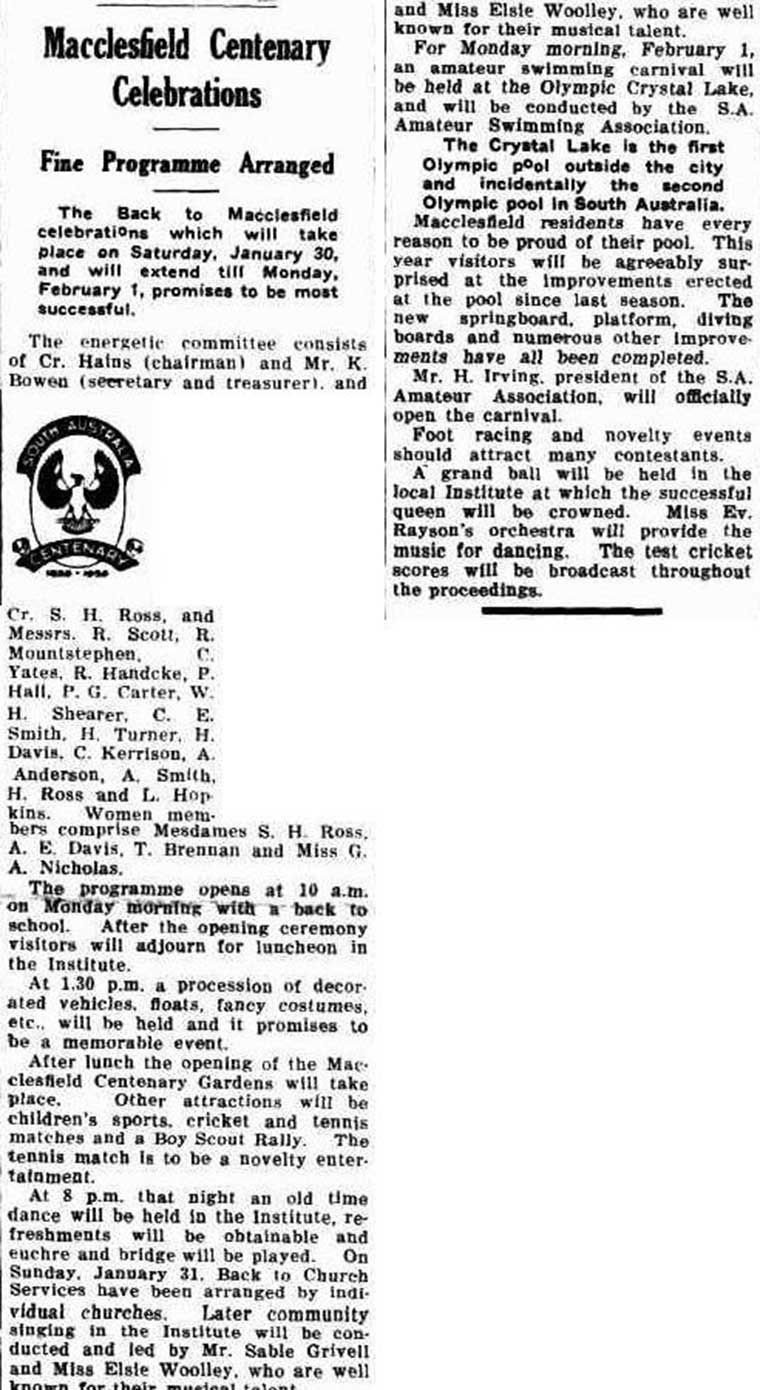Crystal Lake Park and Swimming Pool
Link to sculpture website www.crystallakepark.com.au.
• Macclesfield's Crystal Lake Swimming Pool
• Crystal Lake Campsite
• Crystal Park Olympic-size Pool
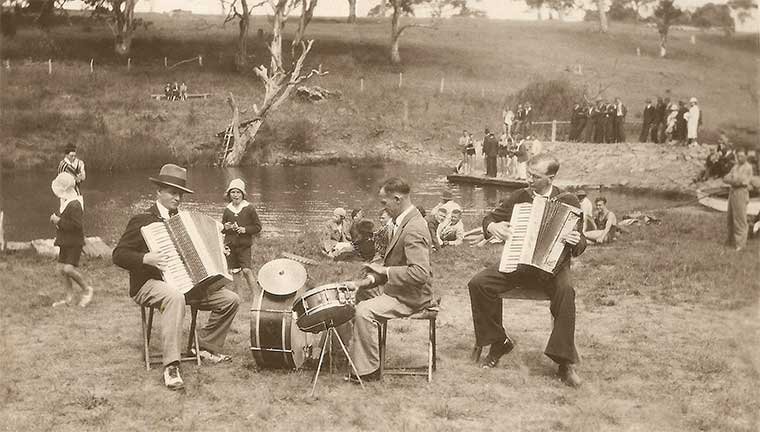
Musicians play at the opening of the Crystal Lake swimming pool in 1932. The left end was very deep as you could dive down into it. A diving board was added near the tree at a later date.
Macclesfield's Crystal Lake Swimming Pool
In 1930 one of the biggest community ventures in Macclesfield's history began when the Council appointed a working committee to investigate the feasibility of constructing a swimming pool for the use of residents utilising the course of the River Angas.
When the idea of a weir across the river was suggested it brought a protest petition with 54 signatures. The Progress Association of the town however was strongly in favour of the project and so the Council conducted a ratepayer's poll on the issue. The results were 90 votes in favour of the weir and a swimming lake and 54 votes against.
The Council celebrated their victory with a free dance in the Institute. Admission was given to all comers who mentioned the password 'Progress'.
In July of 1931, on Arbor Day, a crowd gathered at the site of the proposed lake in the southern parklands of the town and some of the oldest and best-known residents of the district were invited to plant pine trees to help beautify the surrounds. Those that planted trees were: S Ross, W Tonkin, T Lane, J Daly, R Scott, T McNamara, H Turner, C Yates, F Barnett, B Stubbs, P Magin, L Von Doussa, J Elliott, C Dumas, S Davis, R Tonkin, W Anderson, A Gooch, J Ross, Maurice Murphy, W Dancker, G Wyatt, W Wakefield, P Cosgrave, T Ross, HJ Schmidt, P Nestor and J McMahon.
The Mount Barker Courier reported that 'behind the movement the District Council of Macclesfield stands solidly and the Progress Association is to be congratulated on being able to convince the Council of the proposed step and it is safe to say that when the whole is completed it will prove a healthy rival to the Silver Lake at Mylor'.
The Correspondent in the paper went on to say that H Pfeiffer had offered to lend £350 at Savings Bank interest for the project and that the Government had sent officers for the purpose of making a survey of the site. It had been found that the weir would need to be 20 feet high to give the desired stretch of water.
On August 5, 1931, Council members J Daly (Chairman), G Penna, B Stubbs P Magin and E Fry attended a special meeting to peruse and discuss the plans for the weir and the lake. It was decided to accept the tender of Mr. A Altmann (£335) for the construction work but the Council insisted that local men were to be given preference for all work on the job. Jack McMahon was then appointed overseer of the works and the Progress Association was granted a pound for pound subsidy for the construction of a road to the pool.
In January 1932 the project was nearing completion, FJ Barnett's tender for catering had been accepted and G McNamara's tender for the position of gatekeeper was also accepted. Messrs. E Peterson, H Turner and H McDonald presented a life saving reel and notices were being made warning people not to light fires in the park or to interfere with the boats. The death of the Chairman, J Daly cast considerable gloom over the whole project but arrangements still went ahead for an opening ceremony in February.
The tragic death of Jim Daly occurred when the lorry, in which he was a passenger, stalled when ascending the hill on Sturt Street, near the Methodist Church. The truck ran backwards and crashed over the side of the bridge killing Mr. Daly. The driver of the truck escaped with minor injuries and shock. At the time of the accident the two men had been taking a load of timber to Crystal Lake which was then in the final stages of completion.
Before an opening of the pool could take place opposition from two quarters had to be dealt with. The Department of Health objected to the pool on the grounds that it was water later used for drinking in Strathalbyn. The Council wrote in reply that the Department was misinformed and that nobody drank the water.
There was also a letter from the Strathalbyn Council objecting to the restricted water flow because of the weir. This was considered by the Macclesfield Council to be largely inconsequential and not of sufficient magnitude to cause the abandonment of the project.
On February 13, 1932 despite inclement weather, more than 400 people attended the opening of the Crystal Lake Swimming Pool by the Director of Highways, Mr. Fleming. The day included swimming competitions and exhibitions in the pool, a dinner at the Davenport Arms and a Ball at the Institute at night.
Council drew up a list of rules including
• 'Scanty bathing costumes are strictly prohibited'
• 'No parading in the Park in bathing costumes without a Wrap covering'
• 'Loitering, Smoking or Bad language within dressing sheds strictly prohibited'.
The pool was an enormous success in the remaining weeks of the summer of 1932 and throughout the following years further improvements were made. The lake was fenced, tennis courts were constructed nearby, a raft placed in the pool, walkways cleared, rockeries built, seating provided, a 'Sheffield running track' was laid down in the park, brush shelters built and a footbridge constructed below the weir.
In 1936 a Macclesfield Swimming Club was formed with President Mark Haines, Secretary K Bowen, Assistant Secretary Mrs. T Brennan, Misses G Davis and J McNamara, Messrs. R Anderson, J Peterson, T McNamara, R Scott, G Boothby, A Edmonds and B Whitehouse. Club Captain B Whitehouse Vice Captain G Boothby, Starter and check starter R Scott and T McNamara, Judges M Haines, C Yates and H Turner. Several swimming carnivals were conducted and a 'Learn to swim' campaign became an annual feature (refer to Macclesfield Reflections along the Angas).
Macclesfield's Crystal Lake Campsite
This follows an article in the October 2020 Newsletter about Macclesfield's historic Crystal Lake Swimming Pool. Lesley Schack
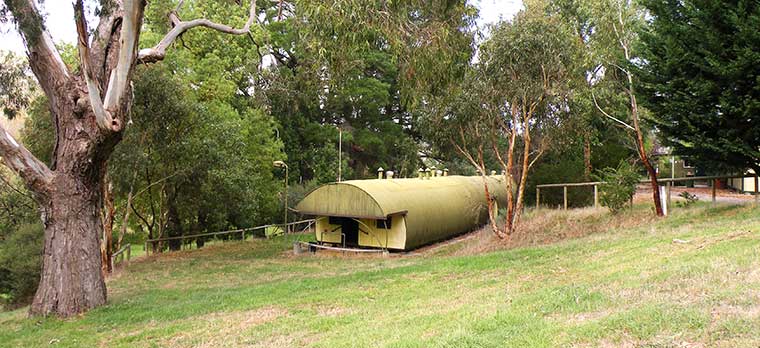
Crystal Lake Campsite
Both the swimming pool and the campsite were located on sections of Lord Robinson Park. The campsite was about 10 acres of land surrounding the pool and it was leased by the Youth Clubs Association in 1960. (The Assoc. was later called the South Australian Community Recreation Association or SACRA).
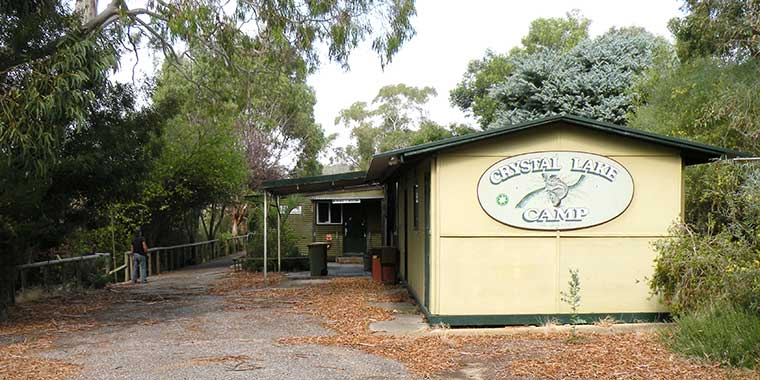
In 1960 the District Council of Meadows and the Youth Clubs Association signed an agreement that allowed the Club to lease the pool area for 21 years at 5 shillings a year, providing they kept all buildings and all other improvements in good repair and condition at their own expense. The agreement also granted public access to the Lord Robinson Swimming Pool for swimming, other aquatic sports or recreation.
During the following years Youth Clubs added further buildings to the site including dormitories, a canteen and shower block, numerous sheds and a house. In 1975 a government grant was provided to enable Youth Clubs to develop a barbeque area, cement paths and to paint the exterior of the dormitories.
In 1980 not long before the lease was due to expire, Meadows Council had the land 'dedicated for parkland purposes' defined as 'for use, benefit or recreation of the inhabitants of that town'.
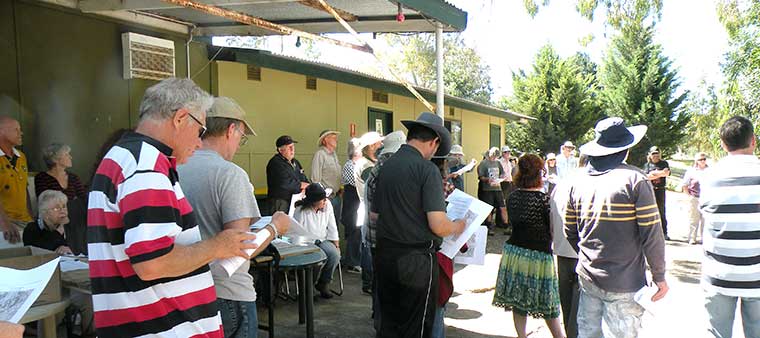
Crystal Lake Camp meeting November 2008
Changes to the local government area in 1983 saw a portion of the District Council of Meadows assigned to the District Council of Mt Barker (DCMB) including the township of Macclesfield, surrounding parklands and Crystal Lake Camp.
Sadly, in 1990 an eleven-year-old boy attending a Salisbury East Primary School camp drowned in unknown circumstances while swimming in muddy water at Crystal Lake. There was a Coronial enquiry into the incident reported in the Advertiser on 13th April 1991.
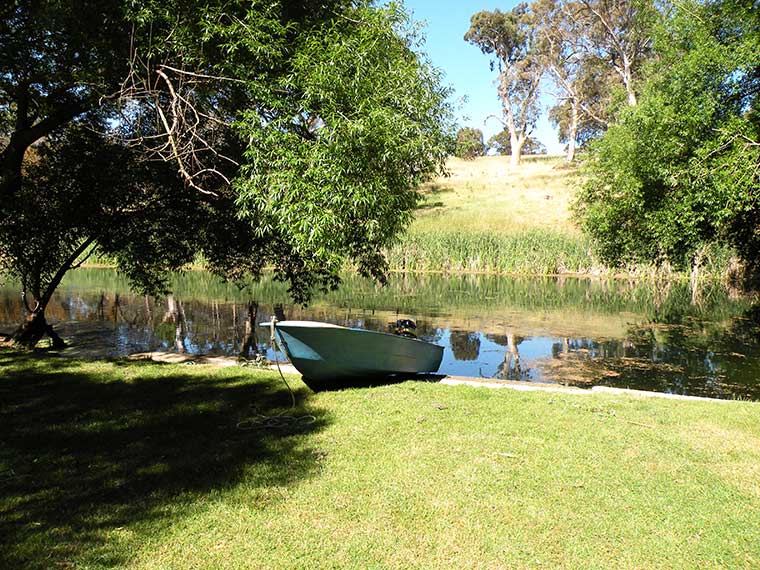
The DCMB managed the Camp until 1993 when they sold the assets; buildings etc. and leased the land to Phil and Chris Coleman. Four years later Robert Carter purchased the assets and signed a ten-year lease on the campsite where he ran a camp accommodation business for school and special interest groups. A DCMB report on Crystal Lake Camp in 2007 stated the camp was well utilised by schools and other user groups from across the state, although the report also raised a question as to 'whether the Council should own a facility of this type' (Community, Recreation & Sport Plan (2004-2007) page 15).
The Crystal Lake Camp lease expired in June 2007. Robert Carter was interested in renewing his lease and wrote a submission to the DCMB outlining his proposal. His preferred option was to purchase Crystal Lake Camp from the Crown. Other options were for a 21-year lease or a lease for 10 years with an option for a further 10 years. He also outlined the benefits the camp provided to the community and argued that as a consequence his rent should be reduced to a Peppercorn lease of 5 shillings ($1) per annum (Lease Renewal Proposal RA Carter 2007).
When the lease expired, he was given a 'holding lease' over the site which provided a month-by-month lease arrangement while the Council sought legal advice and examined the ramifications of his application for a new lease. (DCMB Agenda 21 April, 2008).
In reviewing the existing lease arrangements, anomalies were identified with respect to the lease, such as clarity about the actual boundary of the lease area and the status and ownership of the buildings. To address and clarify these anomalies a community engagement process was instigated.
Following a Community Forum held by the Council in February 2008 to provide background information and to discuss community views on Crystal Lake, concerns were raised about the limited access to the park and the river, land management, environmental and conservation issues and the presence of asbestos and contamination posing health and safety risks.
It was reported in the Council Agenda 21 April, 2008 "A summary of the advice received is: The land is owned by the Crown and under the care and control of Council. On 14th August 1980 the land was dedicated for parkland purposes pursuant to the Crown Land Acts 1929. Parklands are defined under the Crown Lands Act 1929 as: 'lands adjacent to a town and dedicated for the use, benefit or recreation of the inhabitants of that town'. If the land is not going to be available to the public and the public will, in fact be excluded, then the granting of the lease would be unlawful and contradictory to the dedication. The permitted use under the lease with Mr. Carter suggests that the land was available to the general public, however the area is fenced and Mr. Carter's use of the land does exclude the public. It would therefore be unlawful for Council to grant a new lease of the area in its current status (which excludes the general public) as this is contrary to the dedication".
A 'Future of Crystal Lake Camp Options Paper' was prepared for the Mt Barker Council following the Community Forum. The report contained four options and outlined the advantages and disadvantages to Council of each. At its meeting on July 2009 Council resolved 'to implement option 1, which was for Council to undertake an open call for tenders for a commercial lease of Crystal Lake to operate a camp site or similar facility on designated lease area'. Council also endorsed; 'Council staff to undertake the necessary processes in seeking re-dedication of the land'. Further community consultation included an organised site visit in November 2008 attended by Council officers, the lessee and approximately 60 members of the community.
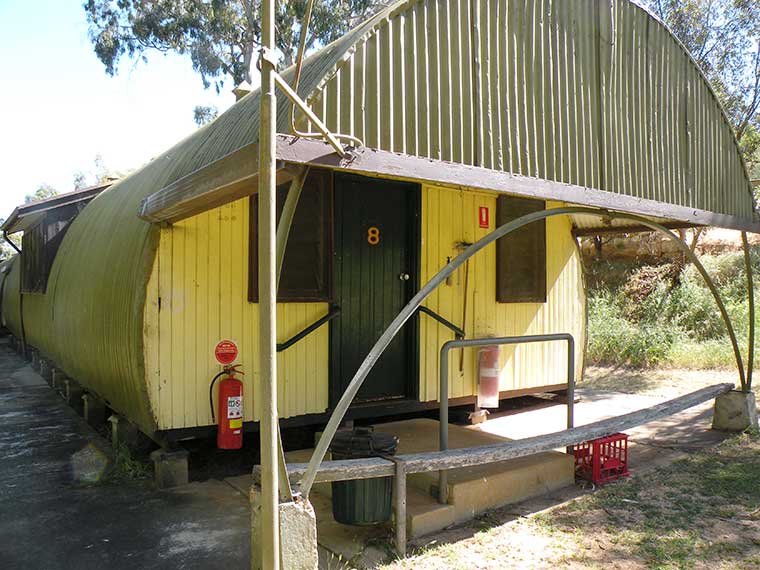
A commercial lease of Crystal Lake legally required that the parkland dedication be replaced. This needed the approval of the Department of Environment and Heritage.
In August 2009 Council applied to the Dept of Environment and Heritage, to 're-dedicate' the most attractive part of Crystal Lake park so that it could lease it commercially to a private operator in the future. 'The lake is still included in the lease area and community access to the creek and permanent water has been considered and accommodated within the creek line immediately above the lake and the creek line below the lake to the property boundary. The eastern half of the watercourse is not included in the lease area and will be directly accessible from the eastern side of Lord Robinson Park. Also removed from the lease area on the eastern side are walking trails and areas that have been the subject of environmental rehabilitation efforts by the Macclesfield Bushcare Group in the past and for which there has been strong representation that they be open and accessible to the general community'. (Council Agenda 2 August 2010).
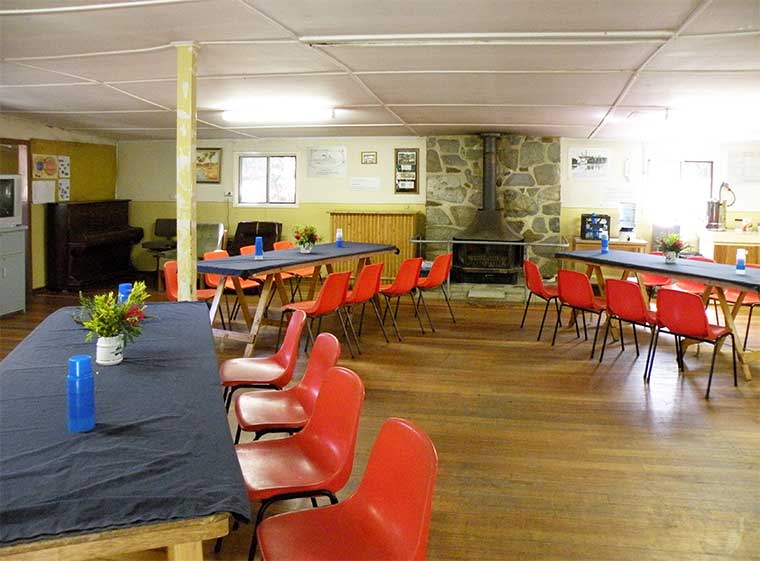
In July 2009 the Lessee had written to Council 'I have been unable to guarantee any future campsite bookings beyond 30 days. Because of this prolonged uncertainty my business has significantly deteriorated to a point where I have incurred significant financial losses. Under these circumstances Council's suggestion to offer any short-term Lease to myself is truly financially untenable'. The Lessee sought to be compensated for the losses to his business due to the uncertainly endured since the expiration of his lease and he asked Council to purchase the buildings to clear the way for improvements to the site for a future lessee. (Carter R 2009, Draft Crystal Lake Camp proposal).
Despite the Council offering the Lessee a choice of two options either an interim lease for a term of 3 – 5 years or a contractual arrangement with Council for a term of 3 – 5 years to manage the Crystal Lake Camp on behalf of the Council (rather than himself) with follow up letter, emails and phone calls the Council received no response from the Lessee. It was then recommended that the Council terminate the current lease arrangement and give the Lessee four months' notice to vacate the site. (Council Agenda 2 August 2010).
A 'Brief for the future use and management of the Crystal Lake Campsite, Macclesfield' was attached to the August 2010 Agenda, 'Council invites submissions from suitably qualified individuals, companies or organisations for the future use and management of the Crystal Lake Campsite'. However, Council was unable to invite submissions for a commercial lease since the former Lessee occupied the site and legally owned the buildings and camp infrastructure.
As no response was received from the Lessee, the Council's only option was to call for tenders for the 'Disposal of Surplus buildings and Assets' on the site. Final tenders closed on 6 January 2012 without any offer. To protect against legal action Council sought court approval to gain 'vacant possession'.
Meanwhile the Adelaide Hills International Sculpture Symposium group (AHISS) were in discussions with the Adelaide Hills and Mt Barker Councils, with the purpose of 'Enriching the hills with sculpture' (AHISS Logo) and linking the hills communities via a sculpture trail.
Community groups were invited to commission one of the eight sculptures initially produced at the Sculpture Symposium to be held in April 2012. Silvio Aponyi, Artistic Director of the Symposium had inspected sites in Macclesfield and was excited by Crystal Lake and also by the proposed use of local marble for a sculpture.
Public support to retain the dedicated parkland status over the whole park grew. In 2012 the community raised over $23,000 to purchase and locate an (AHISS) sculpture on the Crystal Lake site in order to protect public access to the park.
Mt Barker Council suggested the sculpture be located on Davenport Square and proposed a concept of 'dual use' for the Crystal Lake site whereby it could be open to public access when not used commercially.
On the 31st August 2012 the Department of Environment and Heritage, representing the Crown notified Council that a commercial lease of Crystal Lake would not be acceptable. It was this decision from the Crown that prevented Council from commercially leasing the land.
In April 2013 the Council completed the removal of the camp's asbestos clad buildings. The Yoshin Ogata sculpture was installed and the park officially reopened on 13th October with a community celebration.
This article is largely from The Politics of a People's Park, History of Crystal Lake Park Macclesfield (2013) by Dave Welsh. (Copies are available from local libraries at Mt Barker and Stirling and from the State and National Libraries). Dave Welsh has granted permission for the Macclesfield History Group to print this article. Images courtesy of Anne Welsh, photographer.
Crystal Park Olympic-size Pool
Centenary Celebrations: -
Note,
the SA Centenary was actually in 1936, but since there were so many events to fit in one year, some were kept over until 1937.
Maccy held its "Back to Macclesfield Celebrations" on January 30th, 1937, as part of the state's Centenary Celebrations. An amateur swimming carnival was held at the Olympic Crystal Lake, the second Olympic pool in South Australia, as described in the newspaper clipping below.
